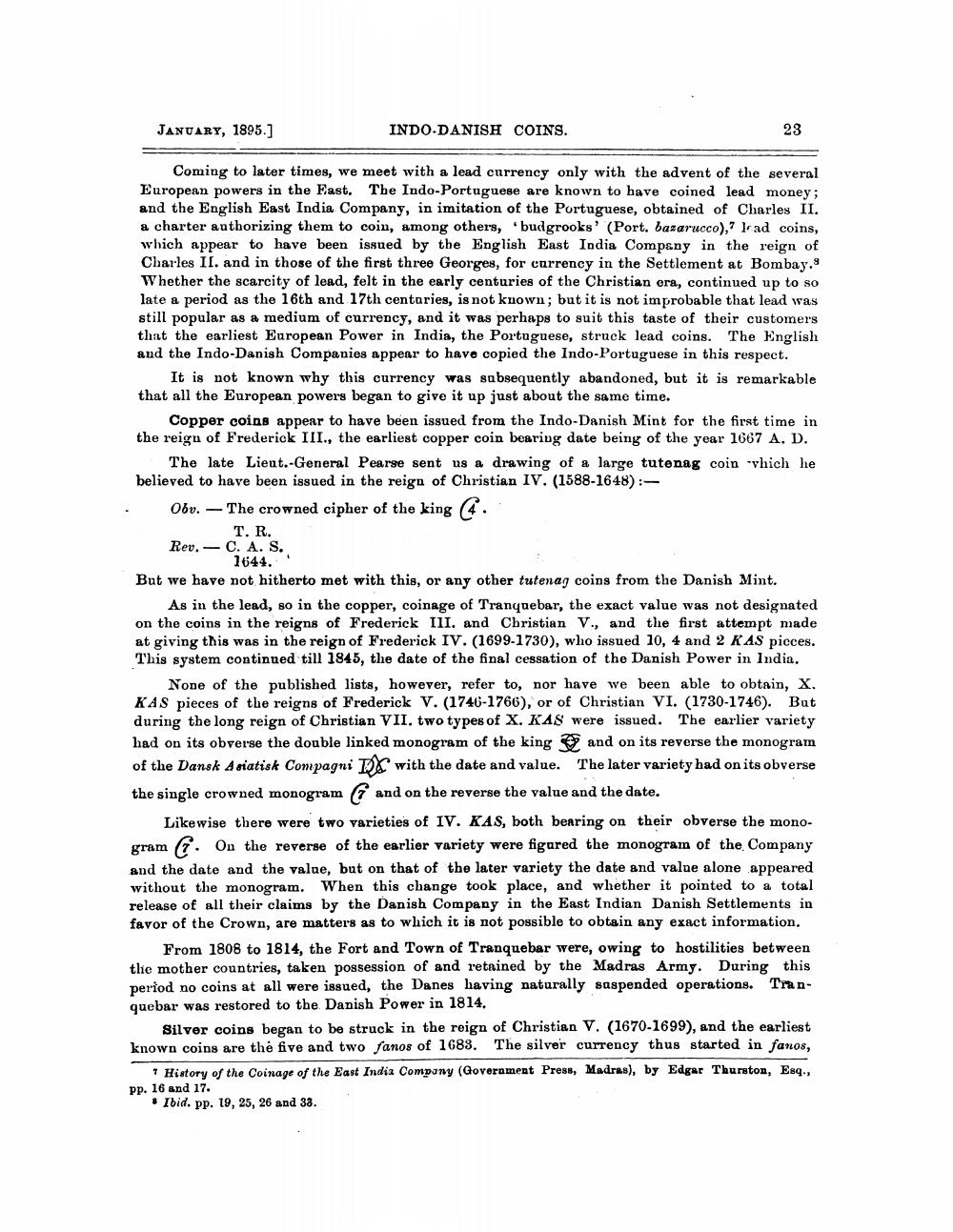________________
JANUARY, 1895.]
INDO-DANISH COINS.
23
Coming to later times, we meet with a lead currency only with the advent of the several European powers in the East. The Indo-Portuguese are known to have coined lead money; and the English East India Company, in imitation of the Portuguese, obtained of Charles II. a charter authorizing them to coin, among others, budgrooks' (Port, bazarucco),? Ir ad coins, which appear to have been issued by the English East India Company in the reign of Charles II. and in those of the first three Georges, for currency in the Settlement at Bombay.9 Whether the scarcity of lead, felt in the early centuries of the Christian era, continued up to so late a period as the 16th and 17th centuries, is not known; but it is not improbable that lead was still popular as a medium of currency, and it was perhaps to suit this taste of their customers that the earliest European Power in India, the Portuguese, struck lead coins. The English and the Indo-Danish Companies appear to have copied the Indo-Portuguese in this respect.
It is not known why this currency was sabsequently abandoned, but it is remarkable that all the European powers began to give it up just about the same time.
Copper coins appear to have been issued from the Indo-Danish Mint for the first time in the reign of Frederick III., the earliest copper coin bearing date being of the year 1667 A. D.
The late Lieut.-General Pearse sent us a drawing of a large tutenag coin vhich he believed to have been issued in the reign of Christian IV. (1588-1648) :Obv. - The crowned cipher of the king (4.
T. R. Rev.-C. A. S.
1644. But we have not hitherto met with this, or any other tutenag coins from the Danish Mint.
As in the lead, so in the copper, coinage of Tranquebar, the exact value was not designated on the coins in the reigns of Frederick Ill. and Christian V., and the first attempt made at giving this was in the reign of Frederick IV. (1699-1730), who issued 10, 4 and 2 KAS pieces. This system continued till 1845, the date of the final cessation of the Danish Power in India.
None of the published lists, however, refer to, nor have we been able to obtain, X. KAS pieces of the reigns of Frederick V. (1746-1766), or of Christian VI. (1730-1746). But during the long reign of Christian VII. two types of X. KAS were issued. The earlier variety had on its obverse the double linked monogram of the king and on its reverse the monogram of the Dansk Asiatisk Compagni Da with the date and value. The later variety had on its obverse the single crowned monogram G and on the reverse the value and the date.
Likewise there were two varieties of IV. KAS, both bearing on their obverse the monogram . On the reverse of the earlier variety were figured the monogram of the Company and the date and the value, but on that of the later variety the date and value alone appeared without the monogram. When this change took place, and whether it pointed to a total release of all their claims by the Danish Company in the East Indian Danish Settlements in favor of the Crown, are matters as to which it is not possible to obtain any exact information.
From 1808 to 1814, the Fort and Town of Tranquebar were, owing to hostilities between the mother countries, taken possession of and retained by the Madras Army. During this period no coins at all were issued, the Danes having naturally saspended operations. Tranquebar was restored to the Danish Power in 1814.
Silver coins began to be struck in the reign of Christian V. (1670-1699), and the earliest known coins are the five and two fanos of 1683. The silver currency thus started in fanos,
7 History of the Coinage of the East India Company (Government Press, Madras), by Edgar Thurston, Esq., pp. 16 and 17.
• Ibid. pp. 19, 25, 26 and 38.




